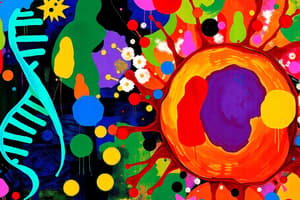Podcast
Questions and Answers
What is the relationship between genotype and phenotype?
What is the relationship between genotype and phenotype?
Genotype refers to the genetic makeup of an organism, while phenotype refers to the observable physical and biochemical characteristics that result from the genotype.
Which of the following is NOT a type of cell signaling?
Which of the following is NOT a type of cell signaling?
- Autocrine
- Synaptic
- Contact-dependent
- Paracrine
- Exocrine (correct)
What type of receptor is responsible for activating a signaling cascade when a signal molecule binds to it?
What type of receptor is responsible for activating a signaling cascade when a signal molecule binds to it?
- Ion-channel-linked receptors
- G-protein-linked receptors
- Enzyme-linked receptors
- All of the above (correct)
The Ras protein belongs to the GTPase superfamily, meaning it can bind and hydrolyze GTP.
The Ras protein belongs to the GTPase superfamily, meaning it can bind and hydrolyze GTP.
What is the function of the Ras/MAP Kinase pathway?
What is the function of the Ras/MAP Kinase pathway?
What are the three main isoforms of the RAS protein?
What are the three main isoforms of the RAS protein?
Mutations in the RAS gene often lead to the development of cancer, but not all RAS mutations are equally oncogenic.
Mutations in the RAS gene often lead to the development of cancer, but not all RAS mutations are equally oncogenic.
What are RASopathies?
What are RASopathies?
Which of the following is NOT a type of cell communication?
Which of the following is NOT a type of cell communication?
What are the major types of cell surface receptors?
What are the major types of cell surface receptors?
Which of the following are examples of signal molecules?
Which of the following are examples of signal molecules?
What are the four major commands that cell signaling can convey?
What are the four major commands that cell signaling can convey?
The Nobel Prize in Chemistry 2012 was awarded for studies of G-protein-coupled receptors.
The Nobel Prize in Chemistry 2012 was awarded for studies of G-protein-coupled receptors.
More than half of all known drugs target G-protein-coupled receptors.
More than half of all known drugs target G-protein-coupled receptors.
Flashcards
Monogenic Phenotype
Monogenic Phenotype
A phenotype determined by a single gene.
Polygenic Phenotype
Polygenic Phenotype
A phenotype determined by multiple genes.
Pleiotropic Phenotype
Pleiotropic Phenotype
A single gene affecting multiple traits.
Genotype-Phenotype Relationship
Genotype-Phenotype Relationship
Signup and view all the flashcards
Signal (Ligand)
Signal (Ligand)
Signup and view all the flashcards
Cell Signaling
Cell Signaling
Signup and view all the flashcards
Receptor protein
Receptor protein
Signup and view all the flashcards
Signaling Cascade
Signaling Cascade
Signup and view all the flashcards
Target (Cell Response)
Target (Cell Response)
Signup and view all the flashcards
Ion-channel-linked receptor
Ion-channel-linked receptor
Signup and view all the flashcards
G-protein-linked receptor
G-protein-linked receptor
Signup and view all the flashcards
Enzyme-linked receptor
Enzyme-linked receptor
Signup and view all the flashcards
Contact-dependent signaling
Contact-dependent signaling
Signup and view all the flashcards
Paracrine signaling
Paracrine signaling
Signup and view all the flashcards
Synaptic signaling
Synaptic signaling
Signup and view all the flashcards
Endocrine signaling
Endocrine signaling
Signup and view all the flashcards
Receptor Tyrosine Kinases (RTKs)
Receptor Tyrosine Kinases (RTKs)
Signup and view all the flashcards
Study Notes
Genotype to Phenotype
- The presentation discusses how genotypes translate into observable phenotypes.
- A classic view shows a linear relationship, but this is simplified.
- Genotypes (genetic makeup) influence molecular-level phenotypes through gene expression.
- These, in turn, create organism-level phenotypes.
Genotype to Signaling
- Genotypes influence signaling pathways.
- These pathways are complex networks of interactions within and between cells.
- Genotype-specific signaling modules can reveal altered genes and their impact.
- This affects molecular, and organism-level phenotypes.
Signaling: Communication Among Cells
- Signaling is essential for cell communication.
- A signal (ligand) interacts with a receptor, initiating a cascade.
- The cascade impacts various targets, like metabolic enzymes, gene regulation and the shape of cytoskeletal proteins.
- This leads to changes in metabolism, gene expression, and cell structure.
What is a Signal?
- A signal is a ligand, a molecule that binds and triggers a response in another molecule.
- Different types of signals include peptides, proteins, amino acid derivatives (like epinephrine, histamine), small molecules (like ATP), steroids, prostaglandins, and gases (like nitric oxide).
Commands of Cell Signaling
- Cell signaling pathways transmit instructions to cells.
- These instructions control a cell's behavior (e.g., survival, division, differentiation, or death).
How Cells Communicate
- Cells communicate via different mechanisms. - Contact-dependent: Signaling cell and target cell are in direct contact. - Paracrine: Local mediators are released and affect cells in the vicinity. - Synaptic: Neurotransmitters are released at a synapse and affect very specific adjacent cells. - Endocrine: Hormones act over long distances via the bloodstream.
Cell Surface Receptors
- Receptor types are categorized by their function and structure:
- Ion-channel-linked receptors: Open or close channels in response to signals.
- G-protein-linked receptors (GPCRs): Activate intracellular signaling pathways via G-proteins.
- Enzyme-linked receptors: Possess enzymatic activity, or directly associate with enzymes upon activation.
Receptor Tyrosine Kinases (RTKs)
- RTKs are cell surface receptors.
- Ligand binding triggers dimerization, activating the tyrosine kinase domains.
Dimerization
- Dimerization is crucial in RTKs.
- The process brings receptor parts together for intracellular signaling.
- Many growth and development factors use RTKs.
Activation via Cross-Phosphorylation
- Receptor activation leads to cross-phosphorylation of tyrosine residues.
- This process initiates intracellular signaling cascades.
Different Receptor Tyrosine Kinases
- Several RTKs exist.
- They have specific structures for specific functions.
G-protein Coupled Receptors (GPCRs)
- GPCRs are the largest family of cell surface receptors.
- Various signals (lights, peptides, lipids, sugars, proteins) activate GPCRs.
- Many drugs act through GPCRs .
G-Proteins
- G-proteins are intracellular proteins.
- Heterotrimeric G-proteins: Have α, β, and γ subunits.
- Small G-proteins: Single polypeptide chains.
- RAS protein is a critical part of intracellular signaling.
RAS Monomeric Small G-protein
- Rat sarcoma virus (RAS) plays a crucial role in intracellular signaling.
- RAS belongs to a superfamily of GTPases.
RAS/MAP Kinase Pathway
- The RAS/MAP Kinase pathway is a crucial pathway for cellular functions.
- Activation of the pathway affects transcription factors, ultimately affecting gene expression.
Mutations in RAS genes
- Mutations in RAS genes can lead to persistent activation of the pathway.
- This is closely linked to cancers.
RAS as an oncogene
- RAS proteins, when mutated, can act as oncogenes.
- There are three main RAS isoforms (KRAS, NRAS, HRAS).
Somatic Variations of RAS Cause Malignancies
- Somatic mutations in RAS genes can be a significant driver for cancer development.
Germline Variations Cause Rasopathies
- Germline mutations cause a group of related genetic disorders.
- These disorders are known collectively as Rasopathies.
Studying That Suits You
Use AI to generate personalized quizzes and flashcards to suit your learning preferences.




